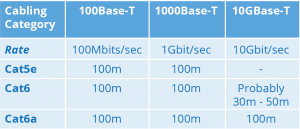Which Category of Data Cabling should I install? If I am planning a new data cabling installation, which category of cable do I install? This blog attempts to help answer that question. The standard of data cabling is classified by category, which specifies which standards and protocols will operate on that cable. The usual categories are known as Cat5e, Cat6, Cat6a and Cat7/Cat7a. As a rule, a higher category means higher performance. In 2015, the great majority of people in the UK are installing Cat5e (20%), Cat6 (55%) or Cat6a (25%), the percentages representing approximate volume of outlets. Cat7 and Cat7a is rarely used in the UK, as it uses non-standard connectors (i.e. not RJ45) and heavily shielded cable (S/FTP), which is really only relevant in specialist scenarios. It is also relatively expensive. I will therefore ignore this option. So it’s really a choice between Cat5e, Cat6 or Cat6a. These are backwards compatible with each other, both physically and in terms of standards and protocols supported. So for example, a Cat6a cabling system will do everything a Cat5e or Cat6 cabling system can do, plus more. You can even mix components, the entire circuit performing as per the lowest performing component. So what is the relative price difference of installing Cat5e, Cat6 and Cat6a? The answer will depend on the number of outlets and installation difficulty, since if the labour costs dominate, the relative cost of the components will have less bearing. However, for a typical installation of a hundred or more outlets, the incremental cost from Cat5e to Cat6 will be 20% and from Cat6 to Cat6a a further 65%. That makes Cat6a roughly double the price of Cat5e. So what are the performance differences? The table below summarises the maximum length supported for the most common Ethernet standards. In 2015, good performance network switches and PC’s come with 1000Base-T ports (otherwise known as or Gigabit Ethernet). This requires cabling supporting 1Gbit Ethernet (1000Base-T), which is true of Cat5e, Cat6 and Cat6a. Maximum length support by different Category cable for common Ethernet speeds. So why install anything beyond Cat5e? It really comes down to future proofing. Replacing a cabling system can be a very expensive and disruptive process, the cost far outweighing the extra cost of installing a better cabling system in the first place. Not necessarily because of the cost of the cabling, but because it will involve moving furniture, taking up floors, ripping into walls etc. So it may not be practical to re-cable your home or premises for another 15 years. By which time IT will have marched on, computers will come equipped with 10GBase-T ports (or faster) and applications will be expecting much higher data rates. Only if you installed faster cabling, are you ready to step up with everyone else. So if my maximum run length is less than 30m, like in a typical home, Cat6 will do the job. Why install Cat6a? And bearing in mind that Cat6a cables tend to be thicker than Cat6 (up to twice the volume), causing possible practical issues. There are actually a number of reasons to choose Cat6a: In summary, we recommend at the very least installing Cat6. The incremental cost over Cat5e is modest and Cat5e will never support 10GBaseT, so has a limited life. The main exception would be if you are building a temporary installation, where it is clear that the cabling will not be used after a short period. Considering Cat6 v Cat6a, it probably comes down to cost. Is it worth paying the extra to have the peace of mind that your cabling will not be a performance bottle neck in five years’ time or even less? We think that the answer is a clear yes. But after all, we are a company who specialises in installing cables.
Tips
Notes

